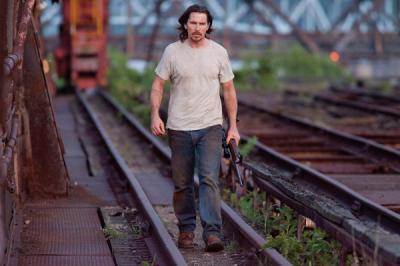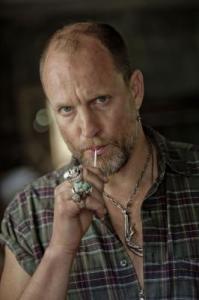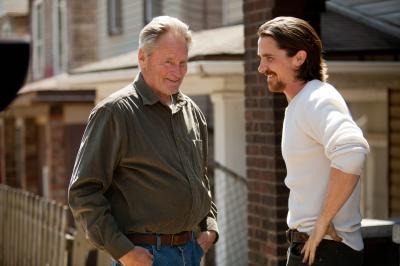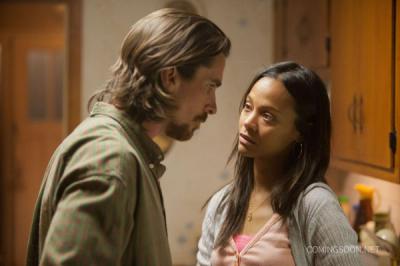By: debbie lynn elias
In his sophomore outing with OUT OF THE FURNACE, writer/director Scott Cooper proves that he is no “flash in the directorial pan.” Facing the daunting task of at least equaling, if not surpassing, the excellence of his award winning debut feature Crazy Heart, Cooper pulls no punches, delivering a prosaically melancholy tale of hearth, home and the ties that bind. Set in the Rust Belt region outside Pittsburgh in Braddock, Pennsylvania, Cooper again embraces the hard-working blue collar men and women of this country and the centuries old code of ethics by which they live. With a deliberate darkness that feeds on the feud between good and evil in man, Cooper infuses OUT OF THE FURNACE with subtextual economic and political commentary on the country as a whole. So thematically well-crafted and structured, the film allows the performances to come to a slow burn before exploding and leaping off the screen, infusing your very soul, and none moreso than Christian Bale and Woody Harrelson.

Set in 2008 (the timeline determined by TV clips of Obama and Ted Kennedy at the Democratic convention) OUT OF THE FURNACE centers around the Baze Brothers, Russell and Rodney. Russell, intense, introverted and methodically deliberate in his choices and life, works at the local steel mill; for how much longer, though, he doesn’t know. The steel industry has taken a hard hit and the Braddock mill is one of the last standing. Brother Rodney is the hot-head in the family. Already having served multiple tours of duty in Iraq, Rodney spends his time gambling, racking up debts that he can’t pay, with people who will find a way to make him pay, thus forcing Russell to step in and try to save his little brother – again. In the meantime, their father is at home dying of cancer, cared for by the boys uncle, Red Baze.
Life for the Baze boys gets a bit more difficult when Russell lands in prison as the result of a fatal car accident in which mother and her young child were killed. While his life behind bars may now be rote, life outside moves on and on his release, Russell finds that his girlfriend Lena has dumped him and is now hanging with the Braddock police chief, leading to a simmering uncomfortable rivalry between Russell and Chief Barnes; Rodney, having pulled yet another stint in Iraq, is back trying to do the right thing and pay his debts to local bookie John Petty. Unfortunately, the only way to come up with the money he owes is by betting on himself in illegal bare-knuckle fights taking place throughout the Allegheny Mountains and clear over to the Preakness Mountains in Bergen County, New Jersey. But most distressing to Russell is the death of his father and that he was unable to attend the funeral.
Taking it all in with tacit introspection, accepting the cards dealt, Russell steps back into his old job at the mill, moves into the old family house trying to spruce it up with a new coat of paint, some new window panes, a new door. A metaphoric Band-Aid for his now life. With Uncle Red as a sage sounding board, Russell’s respite and escape is found while hunting with Red. But the quiet acceptance quickly gets interrupted thanks to Rodney’s activities with Petty and the vilest man around, Harlan DeGroat. Quickly admitting “I got a problem with everybody”, DeGroat is a man who would kill his own mother for looking at him wrong. He has no moral compass and no geographic compass. In DeGroat’s drug-fueled mind, everything is his for the taking. Not only the largest and most profitable drug dealer in the region, but also the man behind the illegal fight clubs, DeGroat is the man whom Rodney crosses. Rule One with Russell, there is nothing stronger than family. Family takes care of its own and you don’t mess with family. DeGroat just messed with family.

Christian Bale is at the top of his game. Bringing a quiet, introspective elegance and kindness to Russell, he is the heart of the film. Everything that Russell does is motivated by his heart and wanting to do the right thing by everyone. Bale embodies the very essence of that with this performance. As emotions run deep and hot, Bale cautiously and deliberately slowly adds threads to the emotional tapestry of Russell until by film’s end, the picture is complete, quiet, still – thoughtful and reflective but with a new light. Based on someone in writer/director Cooper’s life “who has suffered a great deal of tragedy and pain and loss, and who is one of the most positive people that I know”, it was important to Cooper that Russell be a man who is spiritual, who will go to church and sit, think, seek answers and help. “That particular man’s faith has carried him through, whether he’s asking for absolution or for redemption or whatever it is that he’s asking for in those very quiet and personal moments. In these small communities throughout America. . .It was important for me to have Russell Baze ask for that type of spirituality and that faith, as he’s certain that he’s doing things that are very morally questionable and things that have happened in his life that through twists of fate and circumstance have put him in the position he’s in.”
On the flip side we have Woody Harrelson who goes through the roof with his performance as Harlan DeGroat. Beyond entertaining with the slow-boiled violence, Harrelson not only goes out on a ledge, he free falls from it, indelibly etching his performance and the character of DeGroat on your subconscious. The icing on the cake of this tattooed loony, is his favorite mantra tattooed on the sides of his fists. (Ya gotta see it to believe it. And yes, you will laugh.) As related by Scott Cooper, “When we wrapped, Woody walked over to me and he hugged me and he said, ‘I have never wanted to shed a character so badly in my life’.”

For Cooper, his goal was to create and find a dichotomy between good and evil. “I wanted Woody’s character to represent the very worst of America and Christian’s character to represent the very best of America.” He succeeds as the true beauty of OUT OF THE FURNACE is watching the beautiful emotional dance between Bale and Harrelson. They are in perfect synchronicity, the yin and yang to each other, feeding, fueling, leading, checking. This is a dance you hate to see end.
Casey Affleck captures the essence of a man on the edge, a man having endured the horrors of war, a solider quietly suffering with PTSD. Affleck infuses an uneasy, furtive, edginess into Rodney both in speech and manner. His eyes never stop moving, His body is always itching, on the edge, ready to explode like an IED. Broken and flawed, Affleck allows us to sympathize and empathize with Rodney while disdaining his misdeeds. Wanting to be as true to the emotional state of returning war veterans, Affleck talked to some vets, “trying to piece together as much as you can what that experience might be like for somebody and for a lot of these guys. . .They spend a lot of time over there with a constant level of anxiety and understanding what those symptoms are when they come back with some post-traumatic stress disorder [is key]. There’s the depression, the frustration, the alienation and feeling like people don’t want to hear what their experiences were and how lonely that could feel. . .You just hope that all that stuff imbues whatever moment you’re in.” Affleck’s performance is a true emotional balancing act.

As Lena, the rose amongst the thorns, Zoe Saldana adds a tender poignancy to not only the film as a whole, but to the character structure of Russell. According to Saldana, “I think Lena has been torn by her life. She’s probably had a rough life. I needed to build that for her and to understand that. . .I needed to know why she just couldn’t stick by the person that she truly loved and she went with somebody that worked in law that symbolically is going to keep her safe. It has to do with her inability to cope with danger and pain. . .[B]eing torn between two men that have been really good to her is small potatoes in comparison to the torture that she has to live with herself knowing that she just has to make decisions that are going to protect her physically.” Hand in hand with Saldana’s work is that of Forest Whitaker who, as Chief Wesley Barnes, grounds the film in reality for not only Lena, but Russell.
A particularly effective casting is Sam Shepard who, as Red Baze, provides an understated calming, sage wisdom that sets the generational tone necessary for the characters and the history of the region. Willem DaFoe adds some electricity to the proceedings playing both sides of the fence as shady bookie/bar owner John Petty, who’s out to make money but who also genuinely cares about Rodney, thus putting himself between a rock and a hard place. It’s wonderful watching DaFoe squirm to his own devices. A nice turn by veteran Tom Bower who, as Petty’s skittish bartender Dan Dugan captures the voice of the downtrodden yet proud, with a single glance.

Directed by Scott Cooper and co-written by Cooper and Brad Inglesby, it was Cooper’s own history that led him to this story and the town of Braddock. Growing up in a small Virginia town and as the grandson of a coal miner, Cooper had “grown up with these people and have spent a lot of time in small town America.” Learning about Braddock while touring with Crazy Heart, “What the town had undergone over the past five to seven years dealing with economic turmoil and the loss of the steel industry really touched me. It was important to me to really shine a light not only on small town America like that but also what we as Americans have undergone these past five turbulent years. That blue collar milieu was something that I really understood and resonated with me and I thought was under-represented in American cinema. . .I knew these people very well and I knew their mores and their values. . .It was important to weave all of those themes into a narrative in a very personal way.”
Hand in hand with setting the film in Braddock, was the decision to shoot there as well. As the cast agreed, it was especially important with OUT OF THE FURNACE to be immersed in the region, and a part of the community. As described by Bale, “It’s like the difference between performing for the rectangle of the camera versus a world being created and then the camera finds things within that. There’s a huge difference in that, because what it takes away is performance. You don’t feel like performing. You’re just kind of doing it. You’re existing.” With OUT OF THE FURNACE, the performances are anything but “just doing it.” Important to Affleck is that “[T]here’s a real story just in the way that it looks; to see a place that was once one thing and is now something else. It has a lot of atmosphere. If there’s a lighting set-up that takes 20 minutes, you can go into another room and you’re not just staring at the back of a bunch of plywood. You’re actually in another room in your own house where you’re supposed to be, and it helps to ground you and keep you.”

Saldana expounds noting that, “[W]hat you learn and you take from it is the strength that you’re able to absorb from these people. It’s very easy to leave when things go wrong, but to stick around and to basically give life to a town because of everything that it gave you generation after generation after generation, that to me is what defines a true American. It’s sticking together when it gets really rough. It is a town that has been hit very, very hard to an extent that leave you with a big knot in your stomach. . .But once you sit down with the people, you kind of wish you had an ounce of the strength that they possess every single day by sticking around. That was something that I really was very moved by.”
Solidifying his skill as a storyteller, Cooper collaborates with some of the best in the business as part of the production team, starting with cinematographer Masanobu Takayanagi (who wowed us with his work in “The Grey”). Shooting on 35mm film and using light and shadow to create a moody, textured and melancholy reality, laced with a soft cinematic look, the effect is palpable. Showcasing the nuanced beauty of the Allegheny Mountains and the Monongahela River, a graceful lyricism permeates the visual tone, enhancing the surface simplicity that masks the slow-burning sub-text. David Rosenbloom’s editing adds a level of unpredictability that while distracting and feeling unbalanced at times, also serves to jolt one from the seemingly downtrodden and routine world of Braddock and the Baze boys.

Scoring by Winter’s Bone composer Dickon Hinchliffe is effectively haunting while Pearl Jam’s “Release” serving as bookends to the film sets a soulful, and even woeful, melancholy.
Elevated even higher by its performances, OUT OF THE FURNACE is a quiet, observational character study of the human condition and human behavior that delves into the darkness and light of each soul, burning itself into your conscience.
Directed by Scott Cooper
Written by Scott Cooper and Brad Inglesby
Cast: Christian Bale, Woody Harrelson, Casey Affleck, Forest Whitaker, Zoe Saldana, Willem DaFoe, Sam Shepard, Tom Bower












